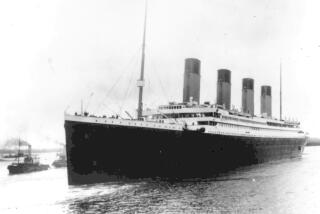‘Titanic’s’ Rider of the Storm
ROSARITO BEACH, Mexico — A young girl is being carried toward a distant lifeboat through a scrum of ruddy-faced men in bowler hats. The unsinkable Titanic has begun to sink.
“That’s very good, Alison,” James Cameron says, purring like a cat reassuring a canary. “Now let me hear you cry. Look over your shoulder and start to cry for mommy.”
Wearing a silver flight jacket to ward off a chill midnight breeze, Cameron speaks into a public address system, his voice echoing across the ship. “Now remember,” he gently instructs the red-cheeked child. “You’re cold and you’re scared and you’re crying for your mother.”
Even with more than a hundred extras, stunt and crew members crowded around, it is unusually quiet on the deck of this massive, 775-foot-long replica of the ill-fated ocean liner. Perhaps it’s because the crew is unaccustomed to hearing such beguiling tones from the autocratic director.
When Cameron calls for action, three camera crews film a mad rush of men surging toward an empty lifeboat, their way blocked by ship’s officers with revolvers. “Give us a chance to live, you limey bastards!” one of them howls. Nearby, Titanic seamen frantically pass out life jackets to wide-eyed women in woolen frocks.
The action is so supercharged that it might seem believable even on a studio sound stage. But it is especially vivid on this hulking shell, its hundreds of portholes ablaze with light. Built to 90% scale, the Titanic’s boat deck stands five stories tall.
If the height doesn’t unnerve you, the deck’s precarious tilt will. A set of hydraulic lifts has pitched the entire ship forward by six degrees, leaving the Titanic’s bow submerged in a 17-million-gallon seawater tank that encompasses 8.5 acres in overall surface area.
Seeing the moonlit waves pounding on the beach below, it is easy to imagine the fearful chaos that erupted the night of April 14, 1912, when the supposedly indestructible ship hit a massive iceberg in the North Atlantic. Mortally wounded, the Titanic stayed afloat less than three hours before plunging into the icy waters, killing more than 1,500 of its approximately 2,220 passengers.
It takes nearly that much time for Cameron to film this one boat deck scene. After a dozen takes, his beguiling manner is gone. Barking orders to his crew, he’s gruff, profane and surprisingly funny. When the speaker system fails, he uses a bullhorn.
For Cameron, making a mega-million-dollar disaster movie is like making war--no quarter is given. A soundman who flubs a take tries to apologize, only to be cut off in mid-sentence. “I know what went wrong,” Cameron snaps. “You weren’t listening for the past 15 minutes.” When a pair of extras botch a scene, he gives them the hook. “See that couple standing between me and my actors,” he tells an assistant. “I don’t want to see them again. Lose ‘em!”
Black ski cap on his head, a fierce glitter in his eyes, the sinewy director, 42, looks like a Navy SEAL preparing for a predawn raid behind enemy lines. “We’re in combat mode here,” he says during a break in filming, which begins at 7 p.m. and ends at dawn. “This scene is about the problems they had launching their lifeboats--and now that I’ve shot the scene, I know why. We’ve got production assistants and walkie-talkies all over the ship and we still can’t find people half the time.”
He shakes his head. “If it’s this [messed] up now, imagine what . . . it must’ve been in real life.”
Cameron has a hand-held camera in his hands--he’s going to shoot much of the next scene himself. “I thought our footage looked too formal, too polite. My goal is to put the audience right on the Titanic, so you feel what it’s like to be going down with the ship.”
Cameron cracks a businesslike smile. “And whatever that feeling is--it is not polite.”
Project Seen as Laden With Commercial Risk
To hear the chatter around Hollywood over the past months, you wonder if Cameron is going down with his ship too. To many observers, the project is burdened with multiple commercial risks: It’s largely set in stuffy 1912, everyone knows how the story ends and Leonardo DiCaprio and Kate Winslet, the young actors playing the film’s fictional star-crossed lovers, have yet to show consistent box-office appeal. As Douglas Coupland put it recently in an essay about disaster films: “What exactly is ‘Titanic’ but ‘The Poseidon Adventure’ minus Shelley Winters?”
A drumbeat of media reports has also portrayed the movie as spiraling out of control, tens of millions of dollars over its already astronomical $110-million budget. Visitors to the set here at Rosarito Beach, 24 miles south of Tijuana in Baja California, have returned with tales of on-set injuries, theft by locals and tyrannical behavior by its director, whose crew on “Terminator 2” made T-shirts saying, “You Can’t Scare Me--I Work for Jim Cameron.”
Early in filming, Cameron clashed with Caleb Deschanel, his director of photography, firing him before the production moved to Baja. But many of the accounts of on-set disaster appear exaggerated. After a recent set visit, Screen Actors Guild investigators said they found “zero proof” to support allegations of health and safety violations.
Producer Jon Landau says there have been no “significant incidents of theft” during production. Reports of a security guard being killed in a barroom brawl turned out to be erroneous, although one crew member was killed after being hit by a car when out walking in a dense fog.
But like “Waterworld” before it, “Titanic” has become this year’s magnet for gossip about Hollywood fiscal meltdown.
In reality, since “Titanic” began filming last July, events have not gone as badly as its detractors say, nor as smoothly as its producers attest. However, insiders familiar with the scope of the film, a co-production between 20th Century Fox and Paramount Pictures, say the movie’s budget has grown to somewhere between $140 million to $180 million.
No one involved with “Titanic” will divulge precise budget information. “No matter what number you put on the budget you sound defensive,” says executive producer Rae Sanchini, who runs Cameron’s Lightstorm Entertainment production company.
However, two barometers indicate a budget gone overboard. Few films are budgeted at more than 100 shooting days. But “Titanic,” which began filming in July and is now slated to complete principal photography in mid-March, is already on a 154-day pace. And several sources predict the film won’t wrap until the end of this month, putting it close to 170 days. Insiders at Digital Domain, the effects firm Cameron helped found in 1993, say “Titanic” will have at least 250 visual-effects shots, an unusually high number.
“With a movie like ‘Titanic,’ you have to deliver what that title promises,” says Landau, a former Fox production executive. “We’re not making ‘My Dinner With Andre’ down here.”
The top executives at Fox and Paramount simply hope to get their money’s worth. Once the cameras start rolling, no studio can control an iron-willed perfectionist like Cameron, who boasts that his 153-page shooting script will spawn an epic three-hour film. Though well-liked by the crew, Landau has so little influence that for much of the shoot Cameron has allowed him to spend only 30 minutes at a time on the set.
“Jim is the 850-pound gorilla--you know going in you can’t control him,” says a high-level studio executive who has worked with Cameron. “Fox has no leverage. What are they going to do--fire him? They need Jim for more than just ‘Titanic.’ They’re dying to make ‘Terminator 3,’ but they could never do it without Cameron on board.”
Still, even Fox wouldn’t bankrollthe film until it found a partner to share the financial risk, and eventually partnered with Paramount, who will oversee the movie’s July 2 domestic release, while Fox handles the film’s overseas release.
While the studios theoretically split “Titanic’s” costs, Fox has the biggest financial risk. Knowing Fox needed a partner, Paramount negotiated a $65-million cap on its participation, so if the film ends up costing more than $130 million, Fox will pay the difference.
Fox has been in business with Cameron long enough to know the score: in for a dime, in for a hundred million dollars. Three of Cameron’s last four films, “Aliens,” “The Abyss” and “True Lies,” were financed and distributed by Fox, which signed the director in 1992 to a 12-picture, $500-million production deal. The agreement has since been drastically scaled back, but after George Lucas, Fox views Cameron as the studio’s most valuable big-screen resource.
‘Titanic’ Unlike Most Action Films
Unlike most action films, which rely on one-dimensional characters and situations, Cameron’s “Titanic” script details a complex human drama, framing a shipboard romance between DiCaprio and Winslet with a present-day account of an aged Titanic survivor coming to terms with the tragedy.
However, much to Cameron’s chagrin, his films’ big-ticket budgets have attracted almost as much media attention as their big-bang creativity. Released in 1989, “The Abyss” was one of the most expensive films of its time, costing an estimated $60 million. In 1991, Cameron’s “Terminator 2: Judgment Day,” made for Carolco, became the first film to top the $100-million mark. 1994’s “True Lies,” originally budgeted at $60 million, ended up costing more than $100 million as well.
Cameron is unapologetic. “I make murals, not paintings,” he says during a 2 a.m. lunch break. “It’s my responsibility to be the throttle. It’s their responsibility to be the brakes. My job is to get all the magical, great [expletive] shots. If they want to stop me, they need a damn good argument.”
The numbers support his case. With the exception of “The Abyss,” which made only a modest profit, Cameron’s films have earned huge grosses, especially overseas. “Terminator 2” has grossed more than $500 million worldwide, while “True Lies’ ” grosses topped the $350-million mark.
That type of performance has earned Cameron a lot of elbow room. In fact, the true testament to his clout is that when he couldn’t find a location with big enough sound stages and water tanks, Fox built him a customized studio lot here in Baja. Constructed last summer in 100 days, the lot cost $20 million, plus another $5 million for the real estate. Known as Fox Studios Baja, the 40-acre facility is a permanent installation that Fox hopes will be a popular destination for other large-scale projects.
Fox Baja has four sound stages, one larger than any on the Fox lot. It offers up to 80 feet of headroom, including a 30-foot subterranean tank where Cameron has built multiple-story Titanic interiors that can be tilted and flooded. The compound also has a permanent 162-foot tower crane that can be used as a camera or lighting platform.
Despite all this impressive technology, the filmmakers say they’ve concocted various cost-saving strategies. One is easily noticeable when the seamen first congregate on the Titanic boat deck. They’re wearing caps that appear to have strange, Cyrillic-style scroll.
Actually, the writing isn’t foreign--it’s English, backward. A sign signaling the entrance to the first-class passengers’ lounge is backward too.
“We’ve only fully built one side of the ship, but to create the illusion that we built both sides we’ll flip the film image,” Landau says. “That gives the illusion that we’re filming on the opposite side of the ship.”
With Cameron, who has a physics degree from Cal State Fullerton, little is left to chance. Before the filmmakers chose Rosarito as their location, they built a 25-foot model of the Titanic and engaged in what Cameron calls “pre-visualization.” Using a tiny lipstick-sized camera, Cameron filmed the model from various angles in a miniature tank. Tests were also run on prevailing wind patterns so that the ship could be positioned in a way that the wind would blow the smoke from its stacks toward the stern to create an illusion of movement.
Similar preparations were made for sequences where hydraulic lifts tilted the ship’s poop deck up to 90 degrees to simulate the sinking. Extras tethered in harnesses worked the less arduous scenes; Cameron used stunt crews for scenes involving tilts steeper than 30 degrees.
Filmmakers say injuries were “limited”--one stuntman broke an ankle, another, two ribs. “We didn’t want anyone on the boat if they had a fear of heights or couldn’t swim,” stunt coordinator Simon Crane says.
On the boat deck, Cameron prepares to film a scene where a steerage passenger is shot by a Titanic ship’s officer. Safety concerns aside, Cameron wants his violence realistic.
His makeup team displays a new batch of fake blood that will be smeared on the wounded passenger. There is some uncertainty about how the blood will register on camera.
“Here,” says Cameron, holding out his arm. “Let’s see how it looks on me.”
“So far, it stinks,” Cameron says with a growl, unhappy with the first four takes of a new scene. After take seven, he grunts: “That’s the first one that’s remotely usable.”
For the past 45 minutes, Winslet has been sprinting up a 100-foot stretch of the slanted boat deck, hysterical with fear, shoving past crowds of worried passengers. Her face flushed, she catches her breath after each take and then returns to her starting mark. He is too absorbed in positioning his cameras to acknowledge her presence.
Winslet says she takes no offense at her director’s lack of encouragement. “Oh, I don’t worry about that,” she says brightly after Cameron shoots the scene’s 11th--and final--take. “If Jim doesn’t talk to me, that means he must like what I’m doing.”
It’s when Cameron doesn’t like what you’re doing that you’re in trouble. Later that night, Cameron explodes when a discussion between Landau and an assistant director disrupts his concentration. “Guys, take it somewhere else,” he barks. “This is no place for a damn production meeting.”
Landau shrugs off the outburst--the “Titanic” producer doesn’t take Cameron’s flare-ups personally, and insists that reports of Cameron’s keeping him off the set are somewhat exaggerated. “Early on Jim did feel my attention was needed in the office,” he says. “But as our relationship developed, I’ve spent more time on set to the point of being there almost all day long.”
Being on board is one thing, steering the ship is another. As Landau puts it: “There’s no doubt that this is Jim’s set.” Cameron provides the sweeping vision--it’s up to others to foot the bill.
Even Cameron’s detractors say it is not waste or incompetence but the filmmaker’s insatiable desire to dazzle audiences that has caused “Titanic” to exceed its original $110-million budget. The demand for splashier movie thrills is so intense that “Titanic” may end up being just one of a dozen films that will cost more than $100 million to market and produce this year. Filmmakers say the pressure for a big summer hit has created an air of willful unreality inside studio executive suites.
“Big action movie budgets have become an elaborate fantasy,” says one top producer. “Everybody tells the other side what they want to hear. The filmmaker says the movie will cost only $100 million so he can get a green light. That way the studio guys can protect themselves by saying, ‘Hey, they said they could do it for $100 million.’ But that’s only if every single thing goes right. The reality is that over the course of a 100-day shoot with a complicated action film, so many things routinely go wrong that the best possible case scenario never happens.”
That’s certainly been the case with “Titanic,” which has suffered more than its share of bizarre problems. Last summer, Cameron spent a month near Halifax, Nova Scotia, filming a series of modern-day scenes that feature Bill Paxton as a fortune hunter diving for the Titanic’s buried treasures.
On the last night of filming, dozens of crew members, including Cameron, fell ill after eating seafood chowder laced with PCP. The filmmakers reject the theory that the poisoning was deliberate, perhaps out of ill will toward Cameron; police say they have yet to apprehend any suspects.
Cameron shot the dive scenes using a high-tech Russian research vessel that has made real-life Titanic dives, even though its Russian crew knew virtually no English. “It was very difficult,” says departed cinematographer Deschanel. “It’s hard enough to shoot on water without adding all the translation problems.”
The Baja segment of filming has been less bumpy. Landau insists filming at Fox Baja has resulted in considerable economic savings. The crew is roughly 70% Mexican nationals, including many skilled trade technicians brought in from Mexico City.
“We’ve had tremendous savings, both with our local work force and our set construction crews,” Landau says. “They’re working for one-fourth of a comparable salary in the States.”
Everyone seems to know enough to give Cameron a wide berth. With months of grueling post-production work ahead, he’s not a man willing to back off on the throttle.
Before striding off to shoot another scene, he gulps down a viscid green health potion that looks like it belongs in a sports car engine. It turns out to be wheat grass. Maybe it works--no one can recall the fiery filmmaker ever running on empty. According to executive producer Sanchini, if Cameron’s energy flags, he gets a B-12 shot.
It’s hard to imagine any doctor convincing Cameron to stay still long enough to take his medicine. “Oh, no,” she says. “Jim gives the shots himself.”
More to Read
Only good movies
Get the Indie Focus newsletter, Mark Olsen's weekly guide to the world of cinema.
You may occasionally receive promotional content from the Los Angeles Times.










